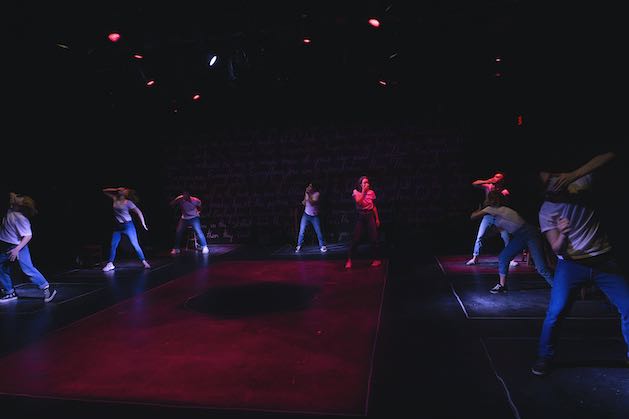
Theatrical space can look empty on video. Still, this show is strong. (Photo by Amir Tabatabaei)
The Doll’s House Project has huge things going for it, including playwright Henrik Ibsen’s shifting moral perspectives and a gallery of fine performances from a bumper crop of student actors. But Laara Sadiq has directed the piece for the stage even though it’s being delivered primarily online.*
Ibsen’s A Doll’s House examines the marriage of Nora and Torvald Helmer, who are on the brink of prosperous ease in their Norwegian town: in the course of the play, Torvald assumes a well-paid position as a bank manager. But, in her innocence and ignorance, Nora has committed a crime, unbeknownst to Torvald, and is soon being blackmailed by the disgraced lawyer Nils Krogstad.
The blackmail plot is the knife that Ibsen uses to pry open the destructive forces of the patriarchy. Torvald treats Nora like a child and, denied overt agency, she acts like one: Nora lies and lacks the resources to control the crisis she provokes — until the ending, when she starts to see her marriage as a prison. In one of the most famous exits ever written, she leaves Torvald and their three children, slamming the door behind her.
Nora’s gesture is, famously, the door slam heard around the world. A Doll’s House caused an international sensation. It was huge in China.
Sadiq cleverly opens with Nora’s departure, allowing us to see the story’s consequences so that we can more clearly track the path that leads to them.
In the script for The Doll’s House Project, which draws on Ibsen’s 1879 text as well as Ingmar Bergman’s 1981 stage adaptation Nora, every scene shifts perspective. Is Krogstad a low-life or has he been unjustly treated? Will Kristine, Nora’s recently returned childhood friend, help her or make her more vulnerable? In Nora, what’s the balance between victimization and complicity?
The project’s two- and three-person scenes provide rich showcases for the student actors. And, in a generous and revelatory move, director Sadiq multiply casts her nine-member ensemble. Everybody in the company plays two or three different characters. We see a parade of different Noras and Torvalds.
The first time my senses clicked into high alert was watching Jacob Leonard and Vuc Prodanovic (both guys) playing the reunion between Nora and Kristine. Without resorting to crude clichés, Leonard and Prodanovic persuasively inhabit these characters as well as the performances of girlishness these characters indulge in.
Sadiq’s casting strategy implies that all of us contain all of the qualities we’re seeing onstage, which is humbling and liberating.
I was particularly taken with Leonard’s Nora, Torvald, and Krogstad. Leonard adds self-deprecating humour to Krogstad’s tale of woe, for instance, lending the character self-awareness, instant three-dimensionality, and an unusual level of likability (for Krogstad). Prodanovic continues to impress and I took special note of the simplicity and authority that Sierra Haynes brings to her assignments, including her no-nonsense portrait of Torvald.
But they’re all good actors. There isn’t a dud in the bunch.
So … about the difficulties of presenting theatre on small screens: if you’re not careful, theatrical space can turn deadly on video and that’s what happens here.
In Jessica Oostergo’s set, everybody who’s not performing in a scene sits on a chair in one of the nine squares that are sketched out on the periphery of the playing area. As the scenes unfold, these peripheral performers execute Noam Gagnon’s choreography, which often consists of synchronized gestures.
My guess is that both the set and choreography would work splendidly in a live performance. But, on a small screen — I watched on my TV — the wide shots of the playing area looked dead, empty, and the gestures had little impact. The three-dimensional event was happening in the theatre, but I was watching on a two-dimensional screen and it didn’t translate.
Because the performance space is echoey, I also found The Doll’s House Project hard to hear when I couldn’t clearly see the actors’ faces. I was desperate for more close-ups, for the intimacy that video can provide. The program doesn’t list a separate credit for video direction and that crucial expertise is missing.
I longed to see The Doll’s House Project live: that’s both a compliment and a complaint. There’s lots to love here and it’s worth watching; there’s nothing quite like being exposed to fresh acting talent after all. But I wanted to experience the riches of this piece in the medium in which it would be most at home.
THE DOLL’S HOUSE PROJECT Based on Henrik Ibsen’s A Doll’s House and Ingmar Bergman’s adaptation Nora. Directed by Laara Sadiq. A Studio 58 production viewed online in a live stream on Saturday, October 10. That performance was recorded and is available on YouTube until October 17 at midnight.
*The Doll’s House Project had a short theatrical run with very limited audiences but, since most audience members will be watching it online, I viewed the livestream.
NEVER MISS A REVIEW: To get links to my reviews plus the best of international theatre coverage, sign up for FRESH SHEET, my free weekly e-newsletter.





Hi Colin
How do I access YouTube to watch this tonight? I seem to be unable to get anything other than the Talkback?
Any suggestion would be welcome. Please
Cheers
Margaret Keane
Hi Margaret. The YouTube link in the review is still working for me. Here it is again: https://www.youtube.com/watch?v=WejDNrQwXPo&feature=youtu.be
The recorded video will be up until tonight (October 17) at midnight.
Best,
Colin